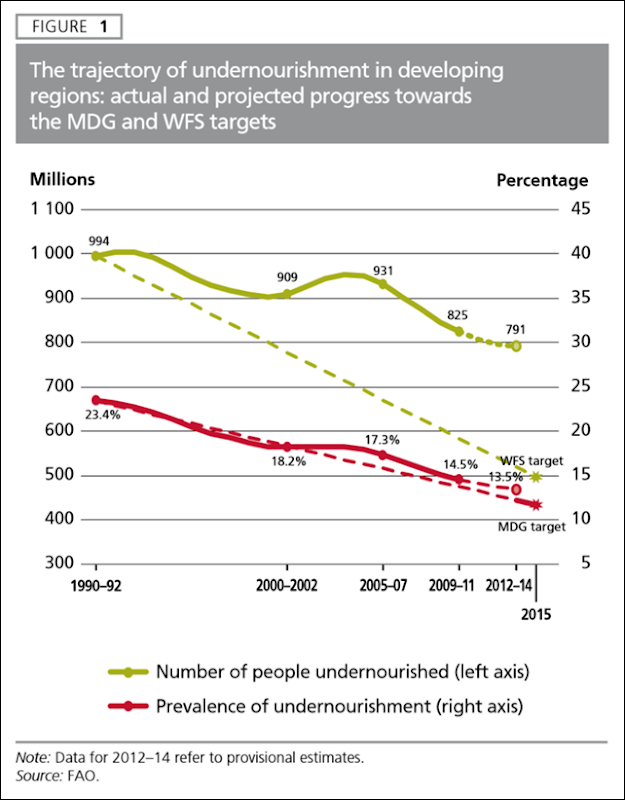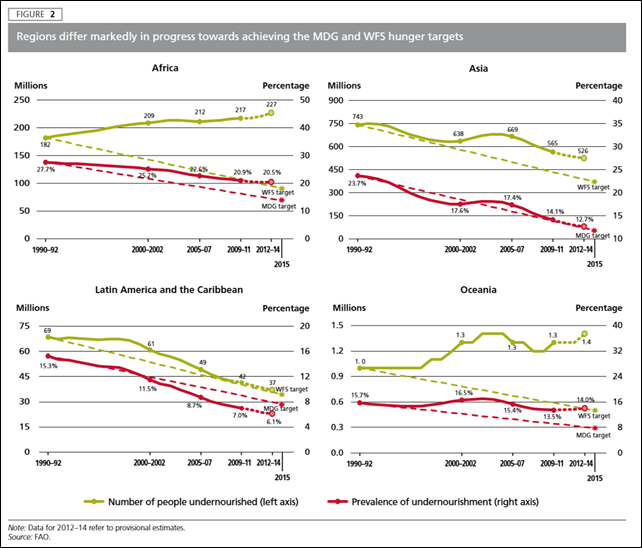Graph of the Day: Progress toward Millennial Development Goals and World Food Summit targets for global food insecurity, 1990-2014
(FAO) – The latest estimates indicate that 805 million people – about one in nine of the world’s population – were chronically undernourished in 2012–14, with insufficient food for an active and healthy life. This number represents a decline of more than 100 million people over the last decade and of 209 million since 1990–92. The vast majority of hungry people live in developing regions, which saw a 42 percent reduction in the prevalence of undernourished people between 1990–92 and 2012–14. Despite this progress, about one in eight people, or 13.5 percent of the overall population, remain chronically undernourished in these regions, down from 23.4 percent in 1990–92. The MDG 1c hunger target – of halving, by 2015, the proportion of undernourished people in the developing world – is within reach, but considerable efforts are immediately needed, particularly in countries where progress has stalled. Despite overall progress, large differences remain across developing regions. Eastern and South-Eastern Asia have already achieved the MDG hunger target. The same is true of Latin America and the Caribbean, while the Caucasus and Central Asia are on track to reach MDG 1c by 2015. Latin America and the Caribbean is also on track to reach the more ambitious WFS goal. By contrast, sub-Saharan Africa and Southern and Western Asia have registered insufficient progress to reach the MDG target. Sub-Saharan Africa has become home to more than a quarter of the world’s undernourished people, owing to an increase of 38 million in the number of hungry people since 1990–92.
The MDG hunger target is within reach…
The decline in the share of hungry people has been more impressive than the reduction in absolute numbers. Between 1990–92 and 2012–14, the prevalence of undernourishment has fallen from 18.7 percent to 11.3 percent at the global level, and from 23.4 percent to 13.5 percent in developing countries. This means that the MDG 1c hunger target of halving the proportion of undernourished people by 2015 is within reach. If the current trend of a reduction of about 0.5 percent per year since 1990–92 continues, the prevalence of undernourishment in developing regions would reach 12.8 percent in 2015 – 1.1 percentage points above the MDG target of 11.7 percent (Figure 1). With greater efforts, particularly in sub-Saharan Africa and Southern and Western Asia, the trend in hunger reduction can be accelerated to meet the MDG hunger target.
…but the World Food Summit target cannot be met
While the MDG hunger target seems to be within reach globally, there is not enough time to achieve the World Food Summit (WFS) target of halving the number of undernourished people by 2015. Despite the progress in developing regions as a whole, large differences remain across regions (Figures 2 and 3). In general, in Africa, there has been insufficient progress towards international hunger targets, especially in the sub-Saharan region, where more than one in four people remain undernourished – the highest prevalence of any region in the world. Nevertheless, the prevalence of undernourishment in sub-Saharan Africa has declined from 33.3 percent in 1990– 92 to 23.8 percent in 2012–14. Growing political commitment to promote food security in Africa is being transformed into concrete results. Strong economic growth (7 of the 10 fast-growing economies in the world are in Africa) is improving the living conditions of its growing population. There is greater recognition of the importance of ensuring peace and stability, the lack of which has been both cause and consequence of conflict that risks thwarting efforts to fight hunger in many countries in Africa. The situation is different in Northern Africa, which has a far lower hunger burden, with the prevalence of undernourishment consistently less than 5 percent since 1990. The apparent abrupt increase in 2012–14 (Figures 3 and 4) is due to the addition of the Sudan to the Northern Africa region.1 Asia as a whole has a prevalence of undernourishment of 12.7 percent, corresponding to 526 million people, or an eighth of the region’s population, chronically lacking access to enough food. As the most populous region in the world, Asia is home to two out of three of the world’s undernourished people. Overall, it is close to reaching the MDG 1c hunger target, but there are large differences across its subregions. Eastern and South-Eastern Asia have already met the target, having cut their undernutrition rates by more than half and more than two-thirds respectively. The Caucasus and Central Asia are also on track to reach the goal by 2015, while lack of progress in Southern and Western Asia makes it unlikely that these regions can achieve MDG 1c. Hunger continues to take its largest toll in Southern Asia, where population growth is high. The estimate of 276 million chronically undernourished people in 2012–14 is only marginally lower than the number at the beginning of the MDG process. Although the prevalence of undernourishment has declined from 24.0 percent in 1990–92 to 15.8 percent in 2012–14, progress is still too slow to allow Southern Asia to reach the MDG target by 2015. The situation is worse in Western Asia, where the prevalence of undernourishment actually increased from 6.3 percent in 1990–92 to 8.7 percent in 2012–14, largely owing to political instability and the deterioration in overall economic conditions during recent years. To date, Latin America and the Caribbean – the first region to publically commit to eradicate hunger by 2025 – has the most successful developing region record in increasing food security. It has already met the MDG target by a comfortable margin and is close to the WFS summit target. Much of the success results from rapid hunger reduction in Latin America, which has reached the WFS target, while the Caribbean has seen slower progress in fighting undernourishment so far. For the region as a whole, the prevalence of undernourishment has declined to 6.1 percent – representing little more than one-third of its hunger burden in the early 1990s. Of all the developing regions, Oceania currently has the lowest number of undernourished people. However, despite the low overall burden of hunger in the region, this number has increased over the last two decades, while the prevalence of undernourishment has only registered a very modest reduction: estimates place undernourishment at 14.0 percent in 2012–14, only 1.7 percentage points below the level for 1990–92. An additional cause for concern is that rising undernourishment in Oceania has been accompanied by a growing burden of overweight and obesity, exposing the region to a significant double burden of malnutrition.

